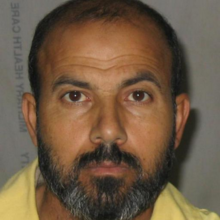Abu Muhannad al-Suwaydawi
Adnan Latif Hamid al-Sweidawi al-Dulaimi | |
|---|---|
 | |
| Born | 1965 Anbar province, Iraqi Republic |
| Died | 7 November 2014[1][2] Mosul, Iraq |
| Cause of death | airstrike |
| Allegiance |
|
| Service | Iraqi Army (1986-2003) Military of ISIL (8 April 2013–7 November 2014) |
| Rank |  Colonel (until 2003) Colonel (until 2003)ISIL Emir of Latakia (2012-January 2014) ISIL Emir of Anbar (January 2014-7 November 2014) ISIL Military Chief (4 June 2014–7 November 2014)[3][4] |
| Battles / wars | 2003 Iraq War Iraqi insurgency Syrian Civil War Military intervention against ISIL |
Adnan Latif Hamid al-Sweidawi al-Dulaimi (Template:Lang-ar, ‘Adnān Laṭīf Ḥāmid as-Suwaydāwī al-Dulaymī), also known by his nom de guerre Abu Ayman al-Iraqi (Template:Lang-ar, Abū Ayman al-‘Irāqī),[5] was a top commander in the Islamic State of Iraq and the Levant and the former head of its Military Council following the death of Abu Abdulrahman al-Bilawi.[6]
Biography
al-Sweidawi belonged to the Al-bu Swda clan of the Dulaim, the largest tribe in Iraq's Anbar Province.
al-Sweidawi previously served under the Ba'athist regime of Saddam Hussein as a lieutenant colonel in the Iraqi Army.[7] He also operated in Iraq's Air Defense Intelligence.[8] Many other ISIL commanders served as military officers during Saddam Hussein's reign including Haji Bakr, Abu Ahmad al-Alwani, Abu Abdulrahman al-Bilawi and Abu Muslim al-Turkmani.
In 2007, he was detained for three years by U.S forces in Iraq, presumably at Camp Bucca. Following his release in 2010, he relocated to Syria where, following the outbreak of the Syrian Civil War, he coordinated ISIL fighters in the cities of Idlib and Aleppo as well as the mountains of Lattakia.[9][10] The Syrian Armed Opposition accused al-Iraqi of being responsible for the assassinations of FSA and opposition figures in Latakia. Following the outbreak of fighting with other Syrian rebel groups in early 2014, al-Iraqi and his men redeployed to ISIL strongholds in eastern Syria.[5]
Despite his senior position within the ISIL hierarchy, very little is known about al-Iraqi. He has been referred to as a "shadowy persona".[11]
On 7 November 2014, a US airstrike targeted a meeting of top ISIL leaders in Mosul, Iraq, killing 20 ISIL militants, including Abu Ayman al-Iraqi.[12][failed verification] He was replaced by ISIL War Minister Abu Suleiman al-Naser as ISIL's Military Chief.[2][failed verification]
References
- ^ "Islamic State leader Abu Bakr al-Baghdadi's close aide killed in US air strike". Telegraph.co.uk. 9 November 2014.
- ^ a b Alessandria Masi (11 November 2014). "If ISIS Leader Abu Bakr al-Baghdadi Is Killed, Who Is Caliph Of The Islamic State Group?". International Business Times.
- ^ "Military Skill and Terrorist Technique Fuel Success of ISIS". New York Times. 27 August 2014. Retrieved 21 October 2014.
- ^ "Ex-U.S. detainees now ISIS leaders". Retrieved 2015.
{{cite web}}: Check date values in:|accessdate=(help) - ^ a b "ABU AYMAN AL-IRAQI DIRECTS ISIS OPERATIONS IN EASTERN SYRIA". Jamestown Foundation. 31 March 2014. Retrieved 5 November 2014.
- ^ "Military Skill and Terrorist Technique Fuel Success of ISIS". New York Times. 27 August 2014. Retrieved 2 November 2014.
- ^ "Key Players: Who's Who in the Battle for Iraq?". NBC News. 14 June 2014. Retrieved 2 November 2014.
- ^ "Exclusive: Top ISIS leaders revealed". Al Arabiya. 13 February 2014. Retrieved 2 November 2014.
- ^ "Profile: The Rise of the Islamic State (IS)". 12 July 2014. Retrieved 2 November 2014.
- ^ "Abu Ayman al-Iraqi". 2014. Retrieved 2 November 2014.
- ^ "A Late-Night Phone Call Between One Of Syria's Top Extremists And His Sworn Enemy". Buzzfeed. 4 April 2014. Retrieved 2 November 2014.
- ^ Sherlock, Ruth; Samaan, Gaziantep; Samaan, Magdy (9 November 2014). "Islamic State leader Abu Bakr al-Baghdadi's close aide killed in US air strike". Telegraph. Retrieved 23 May 2015.
